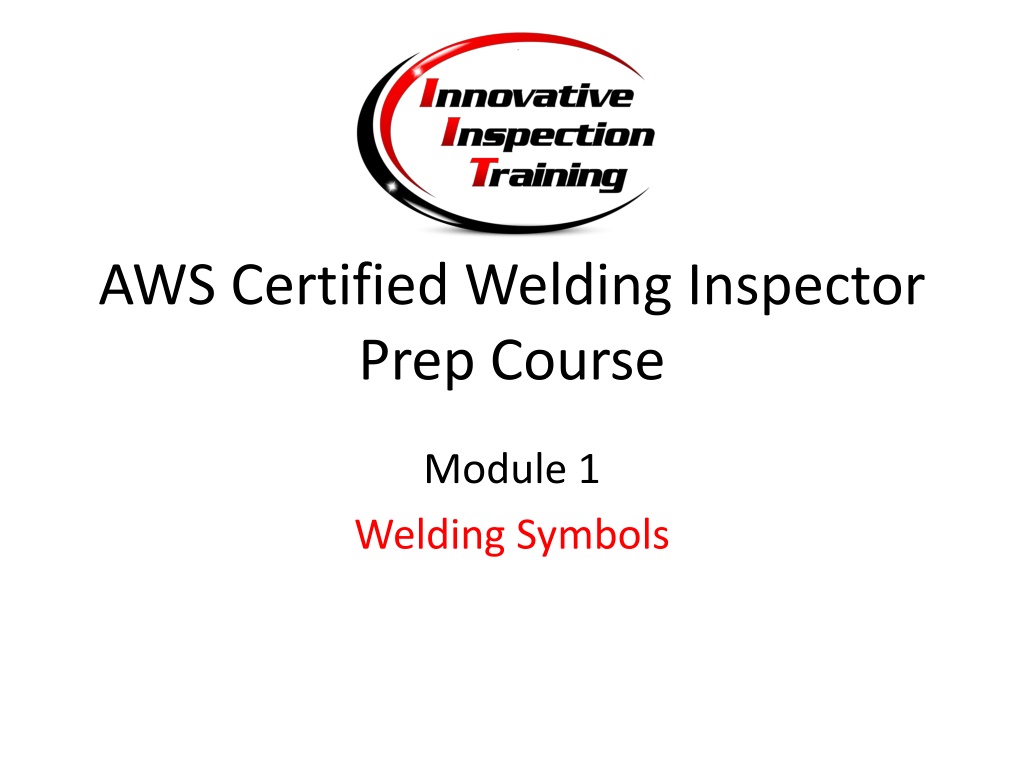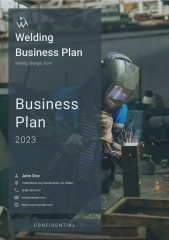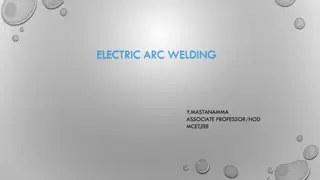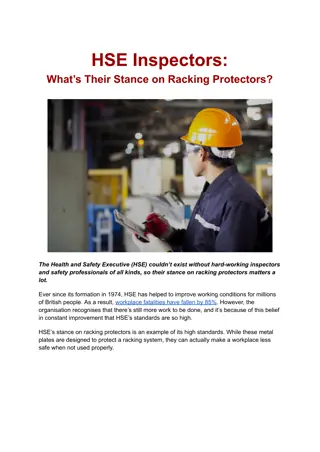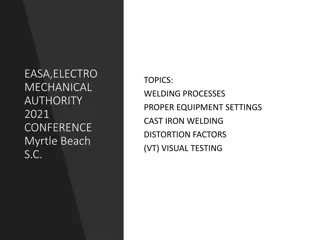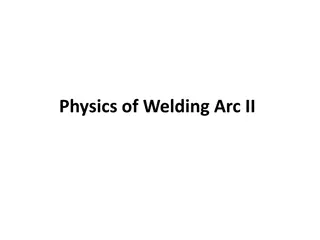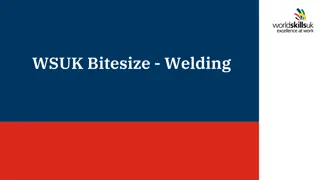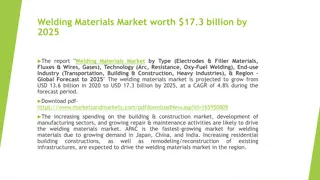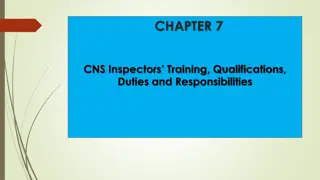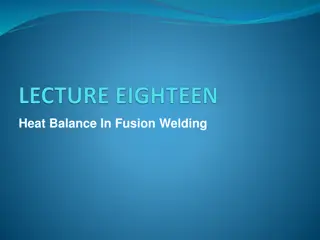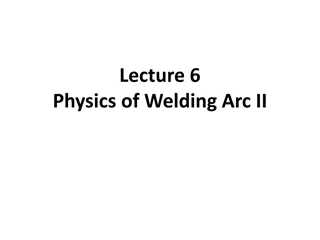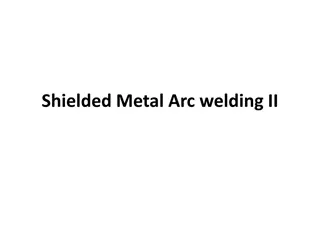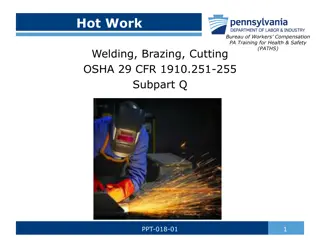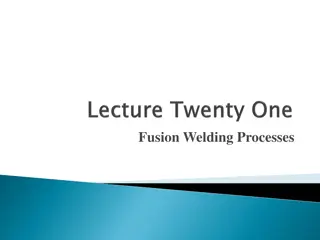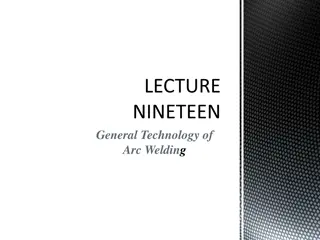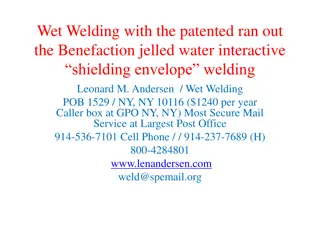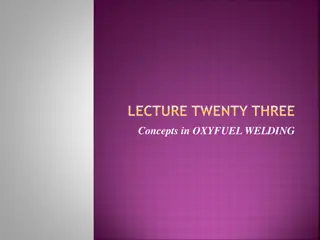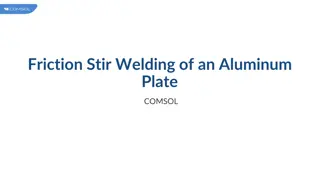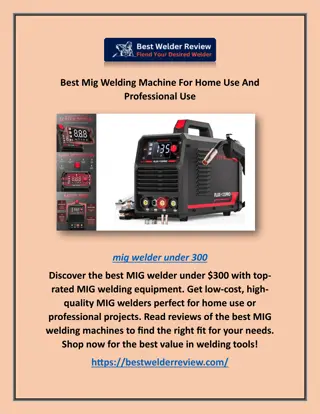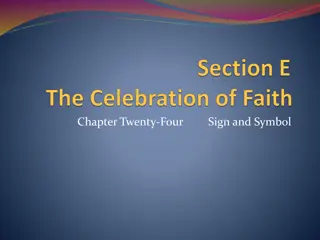Understanding Welding Symbols for Inspectors
Welding symbols play a crucial role in conveying information about weld joints to welding personnel. This module covers the basics of welding symbols, including parts, interpretation, groove welds, fillet welds, plug, and slot welds. As an inspector, it is essential to understand welding symbols to ensure work is performed according to contract documents.
Download Presentation

Please find below an Image/Link to download the presentation.
The content on the website is provided AS IS for your information and personal use only. It may not be sold, licensed, or shared on other websites without obtaining consent from the author. Download presentation by click this link. If you encounter any issues during the download, it is possible that the publisher has removed the file from their server.
E N D
Presentation Transcript
AWS Certified Welding Inspector Prep Course Module 1 Welding Symbols
Introduction The purpose of a welding symbol is so the design professional (engineer) can convey information about a particular weld joint. A welding symbol can contain the following information: Weld Size Weld length
Joint preparation Weld type Complete Joint Penetration Partial Joint Penetration The welding symbol communicates to the welding personnel how to weld a joint
Definitions Welding symbol: A graphical representation of the specification for producing a weld joint Weld symbol: A graphic character connected to a reference line of a welding symbol specifying a weld type. Reference Line: The horizontal line which is a required element of a welding symbol Chamfer: Prepped edge on a several types of groove welds Pitch: Center to center spacing between welds Groove Angle: The included angle between the groove faces of the weld groove. Bevel Angle: The angle between the bevel of a joint member and a plane perpendicular to the surface of the member.
Definitions Root Opening: A separation at the joint root between the work pieces. Contour: Weld profile of a finished weld Finish: How the designer wants the finish of a weld to be obtained. (i.e. grinding, machining, etc.) Backgouge: Removal of weld filler metal. This can be achieved by using several different types of equipment and process; i.e. grinding, chipping, machining, carbon arc gouging, etc.
Examples of Welding Symbols This welding symbol in this plan view detail communicates to the welding personnel how to connect this W column to the baseplate. 5/16 As inspectors you need to know how to interpret welding symbols well, so you can be able to insure work is being performed according to the contract documents.
Example of Welding Symbol 5/16 This is what the actual weldment the designer needs to have the welding personnel complete in order for the structure to be built properly. 5/16
Module Overview This module will cover: Basic welding symbol parts Welding symbol interpretation Groove welds Fillet welds Plug and Slot welds
Basic Parts Reference Line Reference Line (required) Contains the weld symbol and dimensions for the joint
Basic Parts Arrow Arrow (required) Points to the area of the joint where the weld is going to be placed
Basic Parts Tail Contains extra information that cannot be displayed in the welding symbol Tail This explains that the weld symbol information on this welding symbol will be used in 5 places .
Reference Line (required) Arrow (required) Tail
Arrow Side Vs Other Side Other Side Arrow Side Arrow Side is ALWAYS on the bottom of the Reference Line regardless which direction the arrow is pointing to.
ARROW SIDE: Open end of the joint will be on the side of the joint in which the arrow is pointing to OTHER SIDE: Open end of the joint will be on the opposite side of the joint in which the arrow is pointing to.
No Side Significance When the welding symbol straddles the reference line this means the weld has no side significance . Which means the actual fusion takes place in between the faying surface
No Side Significances Symbol Figure Weld occurs between the faying surfaces of the base metal 6 6
Multiple Reference Lines Reference line nearest to the arrowhead will be performed 1st. 1st: Backing weld on the other side 2nd: Bevel weld on the arrow side 3rd: Fillet weld with flush contour on the arrow side
Weld Symbol: A graphic character connected to the reference line of a welding symbol specifying a weld type. The weld symbol is part of the welding symbol . Weld Symbols The weld symbol often looks like the joint configuration preparation. Hint: The vertical line perpendicular to the reference line is ALWAYS on the left side.
Welded joint sequence example Welding symbol Information: V-Groove on arrow side Square Groove on other side Tail: Backgouge before welding opposite side W Joint preparation prior to welding V-groove welded first The root of the V-groove gets backgouged, then square groove side gets welded Both sides complete in accordance with the welding symbol
Combining Weld Symbols Weld symbols can be stacked on top of each other. When welding symbols are stacked, the weld symbols that are closest to the reference line will be performed first. Fillet welds performed after groove welds are referred to as reinforcing fillet welds .
Combining Weld Symbols Welding symbol information: Other side: Fillet weld Arrow side: Bevel groove with a reinforcing Fillet weld Other Side Arrow Side
Fillet weld on the other side Bevel groove weld on the arrow side Reinforcing fillet weld on the arrow side Joint complete according to specifications
Welding Symbol Variables Similar to a math equation, a welding symbol has variables (i.e. S is where the fillet weld size dimension would be placed.). Dimensions are plugged into these variables to convey important information about weld joint.
Groove Welds Depth of Preparation Depth of Preparation For Groove Welds: The S variable is where the engineer places the dimension for how deep the base metal needs to be prepared S S
Groove Welds Weld Size For Groove Welds: (E) is weld size, or the actual Thickness of the weld. The (E) variable will ALWAYS be in parenthesis. Weld Size (E) S (E) S
Groove Welds Root Opening Root Opening R : The separation at the joint root between the base metal R Root Opening S (E) (E) S R
Groove Weld Groove Angle AGroove Angle R S (E) A Groove angle A : The entire angle of the prepared steel (E) S R
Groove Angle Contour Contour A R S (E) A Contour:How the designer wants the surface to appear. Flush Convex Concave Contour shape over joint opening dictates if the weld reinforcement will be convex or concave. Flush (E) S Convex Concave R
Groove Weld Finish F Finish A R S (E) A Finish G- Grinding M- Machining C- Chipping R- Rolling H- Hammering Finish F : How the designer wants the contour finish to be achieved. (E) S R
Contour and Finish Examples Fillet weld on the arrow side with a convex contour using a grinding method. Bevel groove weld on the arrow side with a convex contour. No method specified Bevel groove weld on the other side with a convex contour using a machining method
Groove Weld Weld size VS Depth of Preparation Weld Size: The actual thickness of the weld Depth of preparation: The depth of the chamfered material In this example the Weld Size (E) is greater than the 5/8 V-groove depth of preparation S Hint: Welding symbols without any dimensions on the reference line means that joint will be Complete Joint Penetration (CJP)
Fillet Welds Weld Size Weld Size S Weld Size S : The weld size for a fillet weld is the distance of the shortest leg. S Leg: The distance between the root and the toe S
Fillet Welds Throat Throat S (E) Throat (E): The shortest distance between the root and weld face (E) S Weld face: Distance between toe to toe S
Hint: A fillet weld without a dimension in the L variable means the weld will run the full length of the joint Fillet Welds Length Length Length L : Length of the fillet weld S (E) L L
Fillet Welds Pitch Pitch P : Center to center spacing for intermittent welds ONLY Pitch S (E) P L L L L L P P P
Intermittent Fillet Weld L-P is an instant clue that the weld type is intermittently spaced. L is ALWAYS in front of the dash - and the P . P is ALWAYS a center to center distance. Never clear distance. S (E) L - P
Chain Intermittent Fillet Weld L- P Pitch P Length L
Staggered Intermittent Fillet Weld Length L L- P Weld Symbol: Offset fillets welds signifies staggered spacing Pitch P
Plug Welds Size/ Diameter Size/ Diameter Hint: Slot welds should have the diameter symbol in front of it. S S
Plug Welds Depth of Filling Depth of filling S X S X
Plug Welds Countersink AGroove Angle/ Countersink S X S A X
Plug Welds Contour Contour A S X S X
Plug Welds Pitch Pitch Pitch: Center to center spacing. The illustration shows a center to center distance of 3 . Note: Length or the L variable is not used because plug weld are circles which is given in the S variable for diameter or size. A S P X
Plug Welds Number Number (N) : Variable position that states the number of plug welds in a joint. The (N) variable is always placed underneath the arrowside. In the illustration the (N) variable would be 5. S P X (N) Number
Slot Welds Size and Length Size S : Represents the width of the slot. L represents the length of the slot. Length Size A S X L - P (N) L S
Plug VS Slot Plug Welds S : Represents the DIAMETER of the plug weld and needs to have in front of the dimension L : Plug welds do NOT have lengths Slot Welds S : Represents the WIDTH of the slot weld L : Plug welds have LENGTHS because of the elongated shape.
Back VS Backing Back Weld Back Welds Weld performed AFTER front side of the joint is welded. Welding Symbol Options
